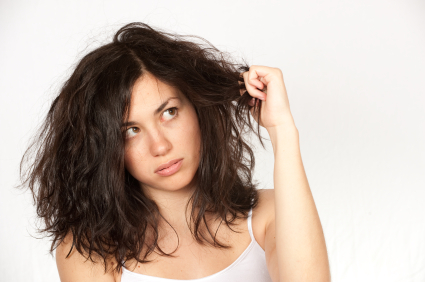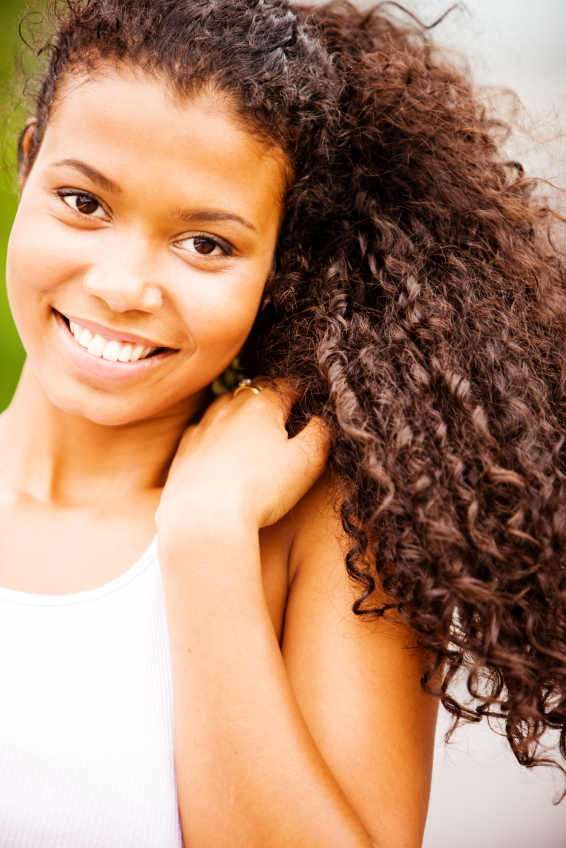This is part one of a four part series: Growing your Hair and Preventing Breakage
Treating the hair like antique lace is the best way to assure that you’ll achieve sufficient length. Some people often get frustrated with their hair ‘not growing’, when it is in fact the ends that are breaking off due to rough handling. In order to prevent the ends from snapping off, one needs to assess how they’re treating their hair and get the protein and moisture balance just right. Of course, the hair is dead once it breaks through the scalp; it is only living below the scalp, so it isn’t hard to damage the hair if you’re not careful with it.
Over Bleaching/over Dyeing:
There’s no secret that repeated chemical treatments such as hair dyes and bleaches can cause copious amounts of damage to the hair. Now, not all hair dyes are damaging to the hair; semi permanent and temporary hair dyes are much better for the hair than permanent dyes and bleaches. Of course, Henna, Indigo, Cassia and Katam are the best dyes for the hair and will cause absolutely no damage. Bleaches and permanent hair dyes are very alkaline and chemically open the hair shaft to pull colour out and deposit some back in. This action repeated over time can severely weaken the hair shaft, causing white dots and bends, then splits followed by breakage.
For those that prefer dyeing their hair, try a semi permanent dye, henna, or vegetable based dye like Manic panic/Pravada chromasilk or anything that doesn’t say “permanent”. A mixture of honey, distilled water, cinnamon and cardamom are great for gradual and safe hair lightening. Lemon juice should be avoided for lightning as it can be very drying, indeed. If you’d rather stick to permanent dyes and bleaches, do your roots only and refresh the length with a vegetable-based dye in a matching colour to minimise damage and brighten the hair. For bleachers/permanent dyers, pre-oiling the hair with coconut oil before lightning can significantly keep the damage to a minimum. Bleachers and permanent dyers benefit from frequent protein and moisture treatments. There are many lovely long-haired bottle-blondes all over the forum with beautiful, damage-free hair. Yes, it is possible. Cassia, is fantastic for brightening and warming up both natural and bottle blondes.
Under Moisturising:
Hair that is brittle, crunchy and fly-away is under-moisturised and requires moisture! Grab a strand of loose hair, and gently pull the strand. Does it break without stretching? Your hair requires moisture via conditioning. Look at the ingredients on your conditioner bottle. Do you see any ingredients that end with “-cone” “conol” or “-xane”? These are silicone based and should be avoided if your hair is lacking serious moisture. While silicones do not actually ‘suffocate’ the hair (remember, hair is dead!), silicones are hydrophobic, meaning that they will repel water, so not much moisture will go in or leave the hair while there is a coating of silicone on the shaft. Before starting any natural hair care routine, it is advised to clarify your hair to remove any build up so that the natural products can work their magic.
Naturally, moisture can be added by oiling damp hair, cover and leave on over night. When your hair is properly moisturised, conditioners containing silicones are okay if you like the way your hair feels with them. If you’re trying to moisturise your hair post protein treatment, make sure your conditioner is a protein-free one. A safe bet are the Suave conditioners, minus the coconut one, just check the label. A great moisturising leave-in is Henna Sooq’s Sweet Mimosa Butter. Superfatted Shampoo Bars will also impart oils to the hair shaft and moisturise whilst gently cleansing without dehydrating the hair. Dry, coarse hair benefits from lots of moisture and gentle cleansing. In the winter, it is best to increase the amount of moisture treatments as the air is much dryer, and heating can greatly dehydrate the hair. Misting the hair with water, then lightly oiling can help with decreasing moisture and protein loss.
There has been much talk on using humectants like glycerin, honey and other syrups for moisturising the hair. The thing with humectants is that if the moisture in your hair is higher than the moisture in the air, the humectants will suck the moisture out of your hair just like those little silica packages, causing dryness and tangles. The key to using humectants is to use them on a rainy or very humid days. Aim for a humidity level of 80; check out the weather network or stick to rainy days. It is always best to lightly oil after a humectant treatment to prevent moisture loss.
Over Cleansing with Commercial Shampoos:
Commercial shampoos contain sulfates, which are very harsh on the hair. They will strip your hair of its natural oils. Harsh shampoos can in fact cause very oily hair and scalp. The more you use harsh shampoos, the more oil your scalp will produce in order to keep your scalp from drying out. Try gentler washing methods such as Shampoo Bars, Aritha, Shikakai, Hibiscus (very gentle, doesn’t remove heavy oilings on its own), Rhassoul or conditioner. Conditioner? Won’t that just make the hair super oily? Nope, not at all! Conditioners contain emulsifiers which help oils and water combine (check out this blog post for information on how to wash with conditioner only) making them effective for removing excess oils from the hair without stripping.
Lack of Protein/Too Much Protein:
Our hair contains keratin, which is a type of protein. A protein treatment fills in all the gaps on the hair shaft and helps keep our hair healthy, strong and happy. Take a loose hair, wet it, grab each and and gently pull. Did the hair strand snap? If yes, you need several moisture treatments. If the hair strand stretched without snapping and does not return to its natural state, then your hair needs protein*. Always follow protein treatments with non protein moisture treatments. A good natural protein treatment is coconut milk or egg yolks.
*In a conditioner or shampoo, proteins are listed as:
- Amino acids
- Hydrolyzed anything
- Protein
- Coconut conditioners usually have quite a bit of protein.
Look for words such as ‘strengthening’ and ‘fortifying’. Great natural protein options are egg yolks, coconut milk, Braggs Liquid Aminos, which is like soy sauce, but without the added salt (1 tablespoon in 1 cup of water as a post wash rinse, or add a little to conditioner or any herb or moisture treatment). Oiling the hair after a protein treatment will prevent protein loss. Protein loss happens while we wash our hair.
Stay tuned for part 2 of “Growing your Hair and Preventing Hair Breakage” where we’ll be talking about hard water, heat styling tools, build-up, rough handling, diet, and more!








I enjoy this post. I’ve been growing my hair naturally for almost a year with very slow progress. After reading tons of information, this has been the easiest and understandable.
April, thank you! That means a lot to us.
It really does! Thank you, April!
Thanks for this all the 4 posts. It gives new awarensss of hair care and helps to better take care of one’s hair.
I like your shampoo bars as well, since it leaves my scalp very clean and makes my hairs feel soft and healthy. The result of using henna and bars , is now I have less breakage and hair fall.
Also your cocoveda hair oil is very good, I feels together it is making my hair strong and more manageable.
I use camelia oil as moisturizer on face after bath. My skin is liking it and I can say that because I am getting compliments at work for it.
Thank you Sarika for your comments!!
Nice article! I knew about using moisture after protein but was unsure of the protein in my conditioner. (I have the Suave Coconut). So it is better to do a protein treatment that is not in the conditioner and follow w/non-protein condish? I am interested in shampoo bars but I have hard well water, will I have problems using them because of that? I love your organic Camellia oil, it is light enough to use on my face before makeup (BB cream) and has worked wonders on my undereye circles! My hair loves it too! I also have your Red Raj (love it) and Hibiscus powder, but don’t know how to use the Hibiscus on its own, I bought it to boost the red in the henna.
With hard well water, Heather, you would more then likely have to make sure to do ACV rinses to balance them out. I’d recommend you try using protein treatments and when you do use non-protein conditioners so as to not overload your hair. Thanks for your amazing feedback!
I’ve come across your insightful and delightful website in search of help for my dry, frizzy, unruly, and hard TWA and read about the Amino Acids. Remembered I had some of that in the fridge from my cherry lola treatment. Had decided to do a CLT and realized I was out of yogurt, so I had to revamp the recipe to suit my needs. I mixed Cholesterol Deep Repair Mask, baking soda, AA….viola my curls had soooo much pop, moisture, and life. Yay!! But, I have a question….I also add a few drops to my styler cream…is this too much protein? Or is it okay as long as I do my protein free moisture treatments on a weekly basis? Or should I just use cowash with protein free conditioners in the between time to avoid protein overload?
I’d recommend you rotate your protein treatments to every few weeks (2-3 weeks) just to make sure there is no overload. You will notice if you’re hair becomes protein sensitive or not.
Hi, your post is so helpful. Could you clarify I couple of things?
How do I know if I have protein buildup?
And, your post mentions that if you oil after protein treatment it helps retain protein. If you oil, isn’t hair required to be washed again because it’s oily? thanks for your help!
Hi Maya! Thanks for sharing. We also recommend our Sukesh Ayurveda and Sweet Honey Nourisher which is absolutely amazing: http://www.hennasooq.com